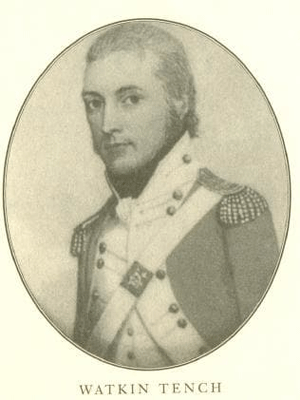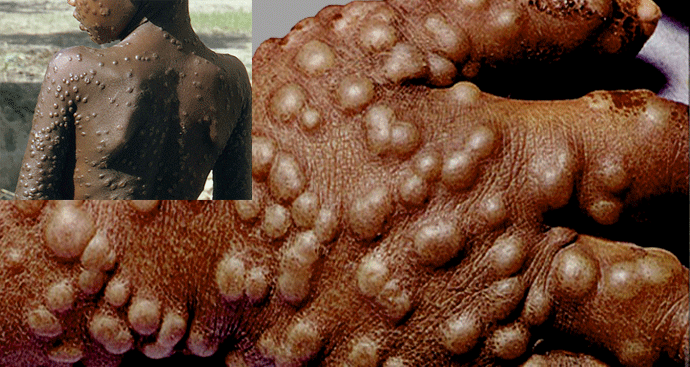Sydney's smallpox outbreak of 1789 - Biological warfare against Aboriginal tribes

An outbreak of smallpox in Sydney in 1789 killed thousands of First Nations people and weakened their resistance to white settlement. Researchers argue that the pandemic was no accident, but rather a deliberate act of biological warfare against the original inhabitants, on the continent named Australia by the perpetrators.
The outbreak of smallpox in and around Sydney 'coincidentally' occurred at the time that there was a shortage of ammunition and following marine captain Watkin Tench writing in his journal that the First Fleet carried bottles of smallpox.
This deliberate infestation was probably the maneuver that determined Britain's permanent occupation of the east coast as Aboriginal resistance was persistent and often co-ordinated. The smallpox infection killed thousands of First Nations people as it spread across New South Wales and deep into Victoria.
There has been some neo-colonial skeptics and cynics regarding this biological warfare with stories of it spreading from other locations etc., but researchers Chris Warrens put all these hypotheses to rest in the video above and its accompanying transcript. Another independent researcher Jim Poulter attests to the deliberate act and provides an insight into how the smallpox destruction wiped out Aboriginal people deep south into Victorian tribes.
Chris Warren ABC Radio National 'Ockham's Razor' 17 April 2014
In April 1789, a sudden, unusual, epidemic of smallpox was reported amongst the Port Jackson Aboriginal tribes who were actively resisting settlers from the First Fleet. This outbreak may have killed over 90 per cent of nearby native families and maybe three quarters or half of those between the Hawkesbury River and Port Hacking. It also killed an unknown number at Jervis Bay and west of the Blue Mountains
History of Smallpox & Diseases 18th - 19th century

THE DUST of THE MINDYE
The use of Biological Warfare
in the conquest of Australia
The plague was released in a deliberate act of genocide by the two top military officers in the First Fleet, and their unwitting dupe was Joseph Jeffries, a Native American ‘Red’ Indian, who was a sailor on the First Fleet.
The author provides some insight into the spread of smallpox into Victoria and beyond.
THE SMALLPOX PDF
by Jim Poulter
To buy direct - Website
(or ask your local library to get it in)
Some authors have argued that the First Fleet had no involvement whatsoever in the outbreak, while others argue that if the Fleet was involved, then it must have been some other disease such as chickenpox - Researcher Chris Warren addresses all the detractors here.
Yet the journal of marine captain Watkin Tench indicates that the First Fleet carried bottles of smallpox. We know that smallpox materials retain the virus for a number of years when exposed to room temperatures. Knowing the temperatures on the First Fleet, it is clear that the virus would have weakened to around half-strength and could easily have caused the epidemic if spread amongst local tribes.
The possibility of chicken-pox has been presented by Dr John Carmody and, hypothetically, a First Fleeter with shingles could have infected Aborigines with this virus, which then manifested as a virulent form of chickenpox.
The chickenpox theory was first floated by Richard Hingston in 1985 and was immediately rebutted by a leading virologist, Professor Frank Fenner. Professor Fenner specialised in smallpox and noted that if chickenpox was present, it would have been seen amongst First Fleet children.
Fenner also raised another problem. Around 1829, smallpox erupted in central New South Wales. A military surgeon, John Mair, investigating the epidemic reported that, those natives with marks from previous smallpox, were now immune from catching the disease. No other disease but smallpox could have arrived with the First Fleet to generate this immunity. Mair’s report therefore demonstrates that the earlier outbreak was true smallpox.
Extracts from Mair’s report have been available since 1919. They were published by the Australian government in John Cumpston’s History of Small-Pox in Australia. It is now not reasonable to reintroduce chickenpox theory today - without addressing the issues raised by Fenner nearly 30 years ago.
Now there is another argument suggesting that the First Fleet was not responsible for spreading smallpox. Some authors have argued that the Sydney outbreak was caused by smallpox from the district of Macassar in the Celebe islands, 3,000 miles away, which just happened to coincide with European settlement.
This Macassan theory was contested by Professor Noel Butlin in 1983 and refuted by Craig Mear in 2008. However, it was revived by Campell Macknight in 2011 and appeared in the Cambridge History of Australia published last year.
We know that in the 18th century, Macassans set up temporary camps along Australia’s northern coastline while processing sea-cucumbers for the Chinese market. If these Asian visitors carried active smallpox, then it is possible that they infected local communities.
Recommended listening
However there was no smallpox at Macassar around the time of the First Fleet. This is clear from the medical history of the Celebes (or Sulawesi as it is now known). The Dutch maintained medical services around Macassar for most of the 18th century and the first report of smallpox only occurred there in 1789, far too late for it to have caused the First Fleet epidemic thousands of miles away near Sydney Cove.
Furthermore, if smallpox entered northern Australia and spread across the continent, it would have left telltale evidence in the form of pock marks along native trade routes. Children along these routes who suffered smallpox in the 1780s would have been in their 40s when Europeans started spreading from Sydney Cove, but there are no reports from early explorers of smallpox scars in inland Australia. On the contrary, as late as 1824 explorers were reporting that smallpox was unknown amongst Aboriginal tribes; that local clans were free of disease; and that their skins were sleek and without a blemish.

The journal of marine captain Watkin Tench indicates that the First Fleet carried bottles of smallpox.
In 2009 another author, Michael Bennett, concluded that smallpox was released from the First Fleet, but he suggested this was a deliberate act by rogue marines or convicts. In effect Bennett corroborated the earlier work by other scholars; Craig Mear, David Day, John Lampert, Norbert Finzsch, Henry Reynolds and Noel Butlin.
Where I differ from both Mear and Bennett is that a close examination of the circumstances suggests that some authority, not necessarily involving Governor Phillip, ordered the deployment of smallpox.
Consider the weakness of the First Fleet’s position initially; it left England in May 1787 without its main supply of ammunition, and without tools to repair its flintlocks. They obtained 10,000 musket balls at Rio de Janeiro, but as this was only 50 balls per musket, this supply would not have lasted more than 12 months. On top of this, by November 1788 the commander of the marines, Major Robert Ross, reported that five muskets were unserviceable and two more were with the blacksmiths who were unable to attend to them. He also reported that their stocks of cartridge paper were damaged and almost useless.
As early as June 1787, Phillip had already sent a plea from Santa Cruz to Evan Nepean at the Home Office requesting that the missing ammunition be sent out with William Bligh’s ship the Bounty. Presumably this was why Phillip felt it was safe to continue the voyage beyond Cape Town. Unfortunately the missing ammunition was never sent, and by early 1789 the marines must have thought their ammunition and tools were never going to arrive.
Even at full strength, the marine force of 160 privates would have been unable to both supervise the convicts and protect the settlement, particularly when the settlement needed to expand to start farming the more fertile land at Parramatta. The strength of the Aboriginal opposition was much greater than anticipated and Phillip advised England that he needed around 500 soldiers plus supervisors for the convicts.

During 1788, conflict increased. This was most likely due to the fact that the British occupied large areas of tribal land and dragged fishing nets through the harbour, seriously depleting Aboriginal food supplies. In the period before the outbreak, 11 marines died or went missing, four more were permanently incapacitated and, typically, over a dozen were on the unfit list. This was out of a total strength of 212.
We also need to recognise that flintlock muskets were not effective against Aboriginal weapons. They were inaccurate at moderate ranges or against moving targets. They misfired and needed reloading after every shot. They had no rear sight and only a rudimentary foresight that was obscured when a bayonet was attached. After an initial period, Sydney Aborigines were becoming used to muskets and less likely to scatter when confronted with them.
In all these circumstances, with no resupply and a dire need to expand the settlement, some marines must have viewed their predicament, and therefore that of the settlement, as either untenable or on the verge of total calamity. At this point in time the release of smallpox may well have occurred as an act of military necessity.
We can be confident that the spread of smallpox was authorised by senior officials because it occurred on the opposite side of the harbour from the settlement. This indicates that boats were used for smallpox deployment, which would have required official planning and sanction because any marines leaving Sydney Cove without permission were court-martialled.
Aboriginal traditions tend to support this analysis. In 1820 William Charles Wentworth noted that the story of the outbreak would be re-told in traditional songs for a long time. In 2001, Dennis Foley published such a traditional account of smallpox from near Balmoral. This account, in Foley’s Repossession of Our Spirit: Traditional Owners of Northern Sydney, contains sufficient detail for it to be corroborated by modern knowledge of smallpox. The quantity and disposition of Aboriginal remains near Sydney also appears to corroborate traditional accounts.
In the 18th century, the use of smallpox by British forces was not unprecedented. This tactic was promoted by Major Robert Donkin and used by General Jeffrey Amherst in 1763, when smallpox-laden blankets and a handkerchief were distributed to Native Americans from Fort Pitt near the Great Lakes.
Nevertheless, we must be wary of judging the use of smallpox based on modern values and modern rules of war. At the time smallpox was released, native people outside the United Kingdom were often seen merely as goods and chattels. Smallpox was released before slavery was abolished and other social reforms were introduced and before more enlightened values and notions of justice prevailed.
What is certain is that if smallpox had not been used, the history of Australia might have been very different.
FURTHER READING:
Journal of the Royal Australian Historical Society, June, 2008 by Craig Mear
(Treaty Republic)
MORE:
Australian Aboriginals: Intentional Genocide by Smallpox Elizabeth A. Fenn
(Treaty Republic)
A Lethal weapon - Smallpox: Boston 1775 - Sydney 1789
(Treaty Republic)



